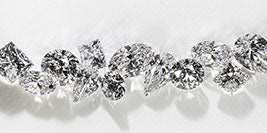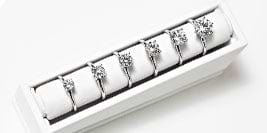By now you’ve most likely heard of lab created diamonds and diamond simulants, but do you know the difference? With so many terms used to label each and an abundance of misleading information available online, we thought it was time to get the facts straight.
Firstly, it’s important to know that lab created diamonds and diamond simulants are not the same thing. They do not carry the same optical, chemical or physical properties, they are not graded the same, and they certainly don’t cost the same. In fact, if you ever see a business or individual advertising lab created diamonds for a couple hundred dollars per carat, run the other way. Let’s explain the difference in a little more detail.
Diamond Simulants
Examples: Cubic Zirconia, Moissanite, White Topaz
The dictionary defines a simulant as something that simulates or imitates. In the case of diamond simulants, these are specifically manufactured to look like natural diamonds, including brilliance and sparkle, but are composed of different materials—they are not made of pure carbon. Their chemical makeup is completely different from that of lab created diamonds or Earth mined diamonds. Common materials used to create simulant diamonds include cubic zirconia (CZ) and moissanite.
What is Cubic Zirconia Simulant?
CZ is made from zirconium dioxide (ZrO2) and is similar, optically, to a diamond. Cubic zirconia is denser than diamond and therefore weighs about 1.7 times more for the same size. CZ is commonly used as an affordable alternative to diamonds in fashion jewelry and can be cut and polished in various diamond shapes and sizes, making it versatile for use in rings, earrings, pendants, and other accessories.
Initially it offers a similar sparkling appearance to a diamond but at a fraction of the cost. However, Cubic zirconia is porous and a softer material than diamond. With a Mohs hardness rating of about 8 to 8.5 (diamond ranks 10), CZ is more susceptible to clouding, scratches and abrasions with normal wear. For costume jewelry that is only worn occasionally, this type of wear and tear on a CZ may not be a concern, but it makes this option a less desirable choice for a forever piece of jewelry.
What is Moissanite Simulant?
Moissanite is a naturally-occurring mineral and is composed of silicon carbide and is named after Henri Moissan, a French chemist who discovered the mineral in 1893 in a meteor crater in Arizona. It has exceptional fire and brilliance but this is known as being double light refractive, which gives it a rainbow sparkle appearance, which is not the same brilliance you get with a pure carbon diamond (aka lab-created diamond or natural diamond).
Moissanite is praised for its durability, as it is one of the hardest gemstones, ranking at 9.25 on the Mohs scale of mineral hardness. This makes moissanite suitable for everyday wear and less prone to scratching or damage compared to other gemstones. The bottom line with Moissanite is whether the rainbow sparkle is appealing, or whether a diamond's brilliance is the wearer’s preferred look.
What is a Diamond Hybrid Simulant?
The Diamond Hybrid® is also a diamond simulant, but we refer to it as a “hybrid” as it is a blend of both simulant and lab-created diamond technologies. Unlike CZ and moissanite, the Diamond Hybrid is infused with an outer layer of lab created diamond to improve beauty and durability (almost three times as hard as a CZ) and achieve the best possible colors and clarity. Every Diamond Hybrid is guaranteed to be D to F in color, VVS1 to VS2 in clarity and comes with a grading card from the Global Gemological Lab (GGL) where it is clearly identified as a diamond simulant.
What is a Diamond, Exactly?
Let’s start with a back-to-basics explainer.
Renowned for its exceptional hardness, brilliance, and rarity, a diamond is a precious gemstone that is made from pure carbon—the same element found in graphite (like a pencil). However, a diamond has a specific crystal structure, called a diamond lattice. This is what gives the stone its unique properties, including extreme hardness, refractive index, and the ability to disperse light into a rainbow of colors, also known as fire.
Diamonds are formed deep within the Earth’s mantle under intense heat and pressure and then mined in varied areas across the globe where Kimberlite pipes exist. Kimberlite pipes are unique volcanic pipes and were named after the town of Kimberly in South Africa, where they were first discovered during the diamond rush of the mid-19th century.
Most commonly, diamonds are colorless, but they can also occur in a wide range of colors, including pink, brown, blue, green, and yellow.
What Are Lab Created Diamonds?
Lab created diamonds are real diamonds, also known as lab grown diamonds, laboratory created diamonds, man made diamonds, laboratory grown diamonds and cultured diamonds. By replicating the Earth’s natural growing process in a controlled laboratory environment, we’re able to create pure carbon diamonds that are optically, physically and chemically identical to earth mined diamonds. These diamonds are then graded by the same world-leading gemological institutes that grade natural diamonds.
Building upon years of research and development, scientists have the ability to replicate the earth’s natural process of crystallizing carbon into brilliant diamonds. Lab grown diamonds utilize advanced technology through one of two approaches—either High Pressure High Temperature (HPHT) methodology or Chemical Vapor Deposition (CVD). The highest quality lab created diamonds are usually created via CVD.
What’s more is that lab created diamonds are as real as diamonds that are mined from the earth. They have size, color, shape, and clarity grades, just like natural diamonds. However, these types of diamonds do not come with the environmental, ethical, or human rights concerns that have plagued the natural diamond industry.
What are Some Facts About Lab Grown Diamonds Vs. Simulant Diamonds?
- Simulant diamonds are made from different materials than that of a lab grown diamond. A lab created diamond is created by using a tiny carbon diamond seed and arranging carbon atoms around it, and they are pure carbon, just like a natural diamond.
- Lab grown diamonds earn a rank of 10 on the Mohs Scale of Hardness. This makes them, like natural diamonds, one of the most durable as well as hardest minerals on the face of the planet. Conversely, CZ ranks 8.5 on the Mohs Scale with moissanite attaining 9.25. This means that both are more susceptible to wear over time and could have their surfaces show scratches.
- Lab grown diamond engagement rings are vastly more affordable when compared to a natural diamond engagement ring. However, a simulant diamond will be quite inexpensive when compared to both. It can still be used in an engagement ring setting, of course, which could be ideal for budget conscious jewelry shoppers.
- Simulant diamonds and lab grown diamonds are both created in a laboratory environment. A diamond simulant, however, does not utilize either of the processes (HPHT or CVD) used when a lab grown diamond is created.
- Both lab grown diamonds and simulant diamonds can offer ethical and environmentally friendly alternatives to natural diamonds. Both have a significantly lower impact on human communities and natural ecosystems, reduce the demand for diamond mining, and minimize the potential for unethical labor practices.
- Lab grown diamonds are considered authentic and are graded via the same system as natural diamonds, called the 4Cs—cut, clarity, carat weight, and color. Additionally, lab grown diamonds can be distinguished as authentic by gemologists using varied tests, including visual inspection or advanced gemological equipment. If a diamond simulant is put through the same evaluation and assessment, a gemologist will be able to identify that the stone is not an authentic diamond.
When to choose a Lab Created Diamond?
MiaDonna’s Lab created diamonds are the perfect choice for those who want to know the origin of their diamond. They are free of any human or environmental abuse, cost a fraction of the price of earth mined counterparts and come in grades superior to those of natural diamonds.
Advantages of Simulant Diamonds
Cubic zirconia and moissanite do offer many advantages to a jewelry shopper and could prove to be a viable option instead of choosing a lab grown diamond. Some benefits of diamond simulants include:
- Affordability is a huge perk and is one of the primary advantages. This affordability allows a wearer to achieve a diamond-like look without the bigger price tag.
- They are visually appealing. Simply put, since simulant diamonds are designed to mimic the visual properties of diamonds, they possess a high refractive index, which results in brilliance and sparkle.
- They come in a wide array of colors, including fancy hues such as blue, pink, yellow, and purple. This flexibility could allow for creative and customizable jewelry designs—at a more affordable price.
- They are widely available in jewelry stores and online, which offers convenience and accessibility to large groups of jewelry shoppers.
When to choose a Diamond Simulant?
Diamond simulants are a wonderful option for those looking to enjoy the glitter and glam of diamond-like jewelry without the hefty price tag. They are also a great alternative for someone looking to change their jewelry on a regular basis. At a lower cost, diamond simulants make it possible to upgrade or change your style on a regular basis without breaking the bank.
A Brief History of the Diamond Hybrid
In 2005, MiaDonna Founder, Anna-Mieke Anderson, embarked on her search for a conflict-free diamond and realized that no stone that comes from the earth could be classified as truly “conflict free”. It was then that she turned to a team of laboratory scientists to grow stunning, authentic, gem-quality diamonds that wearers could be proud of and feel confident that ethics and integrity were upheld in their creation.
At that time, only two labs were growing diamonds—and the technology associated with that process was in its infancy. The diamonds produced in the lab were small and yellow in color, so a “hybrid” simulate was developed and used as a placeholder while technology advanced.
Then, in 2007, Anna-Mieke opened an online business selling a Diamond Hybrid in support of her foundation, The Greener Diamond. The technology behind growing diamonds in a lab never stopped advancing and only continued to get better. Finally, in 2011, Anna-Mieke, through her scientists, was able to grow colorless diamonds up to one carat.
This made MiaDonna the first company in the world to sell pure carbon lab-grown diamonds.
Today, consumers flock to MiaDonna for the best lab created diamonds as well as Diamond Hybrid stones. To learn more about our Diamond Hybrid or our lab created diamonds, we invite you to reach out to us online or visit us in person in our Portland, Oregon store.
This article was updated 6/13/2023, original post published September 2020





























